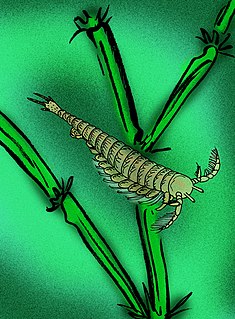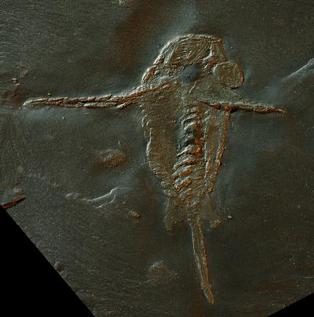 W
WCheloniellon is a monotypic genus of cheloniellid arthropod, known only by one species, Cheloniellon calmani, discovered from the Lower Devonian Hunsrück Slate of Germany.
 W
WFavosites is an extinct genus of tabulate coral characterized by polygonal closely packed corallites. The walls between corallites are pierced by pores known as mural pores which allowed transfer of nutrients between polyps. Favosites, like many corals, thrived in warm sunlit seas, feeding by filtering microscopic plankton with their stinging tentacles and often forming part of reef complexes. The genus had a worldwide distribution from the Late Ordovician to Late Permian.
 W
WJaekelopterus is a genus of predatory eurypterid, a group of extinct aquatic arthropods. Fossils of Jaekelopterus have been discovered in deposits of Early Devonian age, from the Pragian and Emsian stages. There are two known species: the type species J. rhenaniae from brackish to fresh water strata in the Rhineland, and J. howelli from estuarine strata in Wyoming. The generic name combines the name of German paleontologist Otto Jaekel, who described the type species, and the Greek word πτερόν (pteron) meaning "wing".
 W
WLepidocaris rhyniensis is an extinct species of crustacean. It is the only species known from the order Lipostraca, and is the only abundant animal in the Pragian-aged Rhynie chert deposits. It resembles modern Anostraca, to which it is probably closely related, although its relationships to other orders remain unclear. The body is 3 mm (0.12 in) long, with 23 body segments and 19 pairs of appendages, but no carapace. It occurred chiefly among charophytes, probably in alkaline temporary pools.
 W
WMacrodontophion is the name given to a dubious genus of lophotrocozoan from the Early Devonian of Ukraine. It was described by Zborzewsky in 1834, but was never given a species epithet, and is considered a nomen dubium, because it is based on a sole tooth.
 W
WPalaeoconchus is a genus of microconchid tubeworms. Their tubes have pseudopunctae penetrating the tube wall. Tubes lumen is smooth. Palaeoconchus occurs in the Late Ordovician of Baltica and Avalonia. In the Devonian it had a global distribution.
 W
WPalaeoisopus is a monotypic genus of fossil pycnogonid, known only by one species, Palaeoisopus problematicus, discovered from the Lower Devonian Hunsrück Slate of Germany. It have several characters unusual for a pycnogonid, such as swimming legs with alternating size, medially-arranged eyes, and most significantly, a long, segmented abdomen, which were highly reduced in modern counterparts.
 W
WPalaeospondylus gunni is a mysterious, fish-like fossil vertebrate. Its fossils are described from Achanarras slate quarry in Caithness, Scotland.
 W
WParisangulocrinus is an extinct genus of crinoids from the Early Devonian of Europe.
 W
WPleurodictyum is an extinct genus of tabulate corals, characterized by polygonal corallites. Colonies commonly encrust hard substrates such as rocks, shells and carbonate hardgrounds.
 W
WSchinderhannes bartelsi is an anomalocarid known from one specimen from the lower Devonian Hunsrück Slates. Its discovery was astonishing because previously, anomalocaridids were known only from exceptionally well-preserved fossil beds (Lagerstätten) from the Cambrian, 100 million years earlier.
 W
WWillwerathia is a genus of synziphosurine, a paraphyletic group of horseshoe crab-like fossil chelicerate arthropods. Willwerathia known only by one species, Willwerathia laticeps, discovered in deposits of the Devonian period from the Rhenish Slate Mountains of Germany.